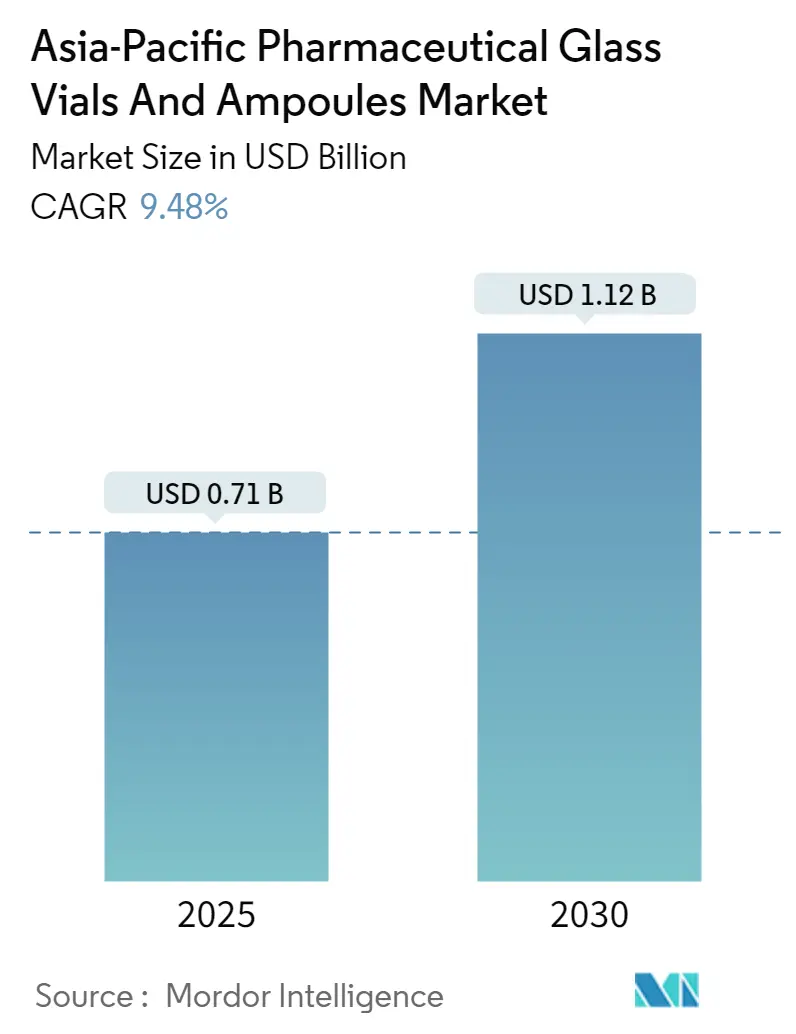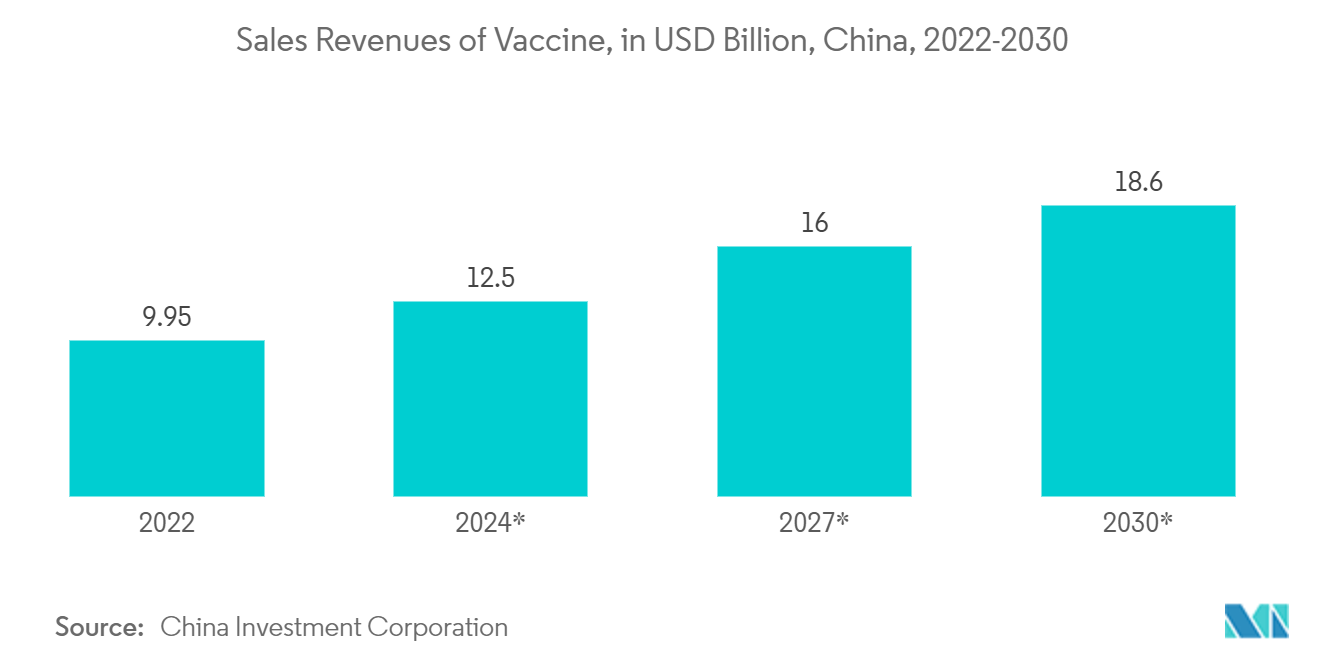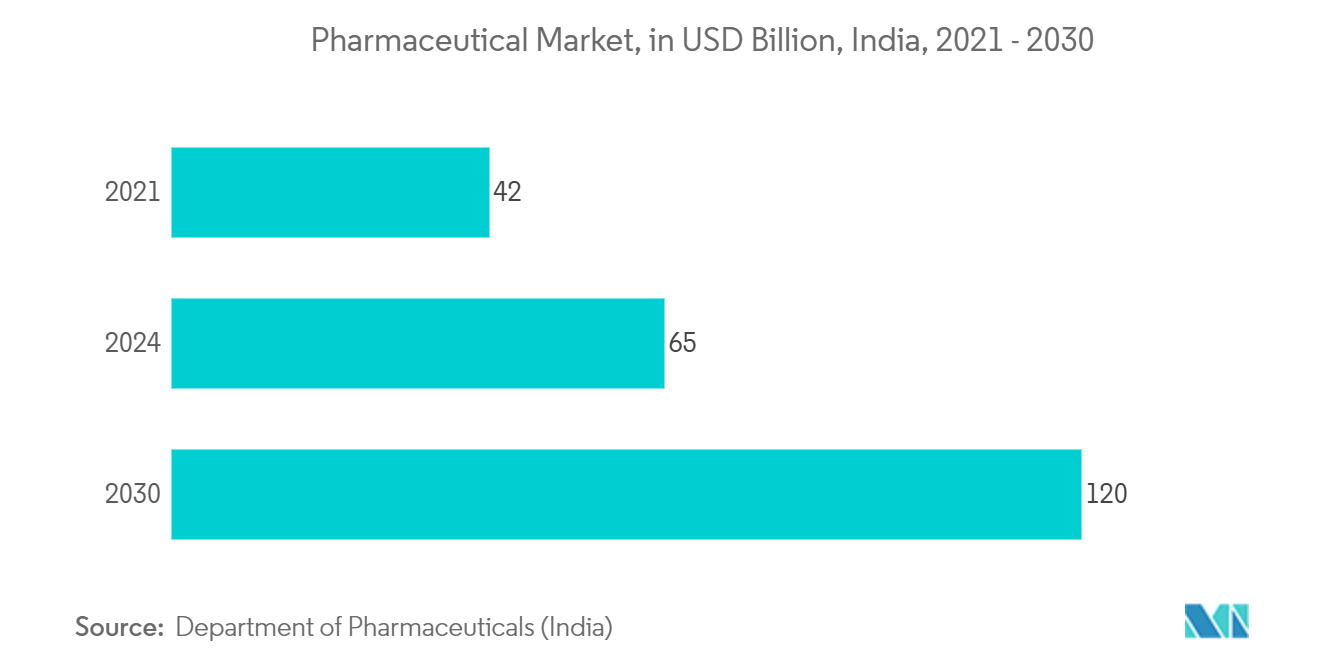
| Study Period | 2019 - 2030 |
| Base Year For Estimation | 2024 |
| Forecast Data Period | 2025 - 2030 |
| Market Size (2025) | USD 0.71 Billion |
| Market Size (2030) | USD 1.12 Billion |
| CAGR (2025 - 2030) | 9.48 % |
| Market Concentration | Low |
Major Players.webp)
*Disclaimer: Major Players sorted in no particular order |
Asia-Pacific Pharmaceutical Glass Vials And Ampoules Market Analysis
The Asia-Pacific Pharmaceutical Glass Vials And Ampoules Market size is estimated at USD 0.71 billion in 2025, and is expected to reach USD 1.12 billion by 2030, at a CAGR of 9.48% during the forecast period (2025-2030).
- Glass remains a preferred material in pharmaceutical packaging due to its ability to contain various chemical compositions safely. Its inert nature prevents interactions with enclosed substances, ensuring product stability over extended periods. Glass vials and ampoules offer superior transparency, enabling easy inspection and monitoring of their contents. This transparency is crucial for quality control processes and allows healthcare professionals to quickly identify any changes or contamination in the medication.
- Additionally, glass packaging provides excellent barrier properties against moisture, oxygen, and other external factors that could compromise drug efficacy. The material's durability and resistance to temperature fluctuations further contribute to its widespread use in the pharmaceutical industry, making it suitable for a wide range of storage and transportation conditions.
- The expanding pharmaceutical industry in the Asia-Pacific region is driving market growth. Densely populated countries exhibit increased demand for pharmaceutical glass vials and ampoules. This demand is particularly evident in nations with large populations, such as China, India, and Indonesia. The rising pharmaceutical production in these nations further amplifies this demand, as manufacturers require more packaging solutions to accommodate their increased output.
- Moreover, the escalating healthcare expenditure in developing countries such as India and China is an additional catalyst for market expansion. This increased spending translates to improved healthcare infrastructure, better access to medical services, and a higher consumption of pharmaceutical products, all of which contribute to the growing demand for glass vials and ampoules.
- According to the International Trade Centre (HS Code-701010), China has become a significant exporter of pharmaceutical glass vials and ampules. This development comes as global demand for these products continues to grow. In 2023, China exported 22,148 tons of ampules, demonstrating its substantial role in the international market. The primary destination for these exports was India, receiving 7,632 tons, highlighting the strong trade relationship between the two countries in this sector. The United States of America followed as the second-largest recipient, importing 4,771 tons of ampules from China. This data underscores China's increasing importance in the global pharmaceutical packaging supply chain and its ability to meet the rising demand for glass vials and ampules in critical markets.
- SCHOTT invested EUR 75 million (approximately USD 81.1 million) over the last three years to expand its pharmaceutical glass production in India to meet the increasing demand in Asia. The Gujarat-based facility serves as the company's manufacturing hub for borosilicate glass tubing, a high-quality material used to produce pharmaceutical containers such as vials, ampoules, and syringes for storing life-saving drugs. This expansion aligns with the Indian government's vision to strengthen India's global pharmaceutical hub position while supporting Germany's commitment to increase investments in India.
- Expanding SCHOTT's production capacity in India addresses the growing regional demand and enhances the country's capabilities in producing critical components for the pharmaceutical industry. This investment is expected to create new job opportunities, foster technological advancements, and contribute to the overall growth of India's pharmaceutical sector. Furthermore, the increased production of high-quality glass tubing will help ensure a stable supply chain for pharmaceutical packaging, which is crucial for maintaining the safety and efficacy of medications in the region and beyond.
- The high carbon footprint associated with glass manufacturing processes challenges market expansion. Glass production typically requires significant energy and generates substantial emissions of greenhouse gases, contributing to environmental concerns and potentially limiting market growth.
- Furthermore, the pharmaceutical packaging industry in the Asia-Pacific is witnessing a growing trend toward adopting alternative packaging materials, impacting the traditional glass packaging market. These alternative materials, such as plastics and biodegradable options, are gaining popularity due to their lightweight properties, cost-effectiveness, and improved sustainability profiles. As pharmaceutical companies explore these alternatives, the demand for glass packaging in the sector may experience a slowdown. This shift in packaging preferences restrains the growth of the glass packaging market, particularly in the pharmaceutical segment, as manufacturers and consumers seek more versatile and environmentally friendly packaging solutions.
Asia-Pacific Pharmaceutical Glass Vials And Ampoules Market Trends
The Vials Segment to Hold Significant Market Share
- The growing demand for vaccines in the region and the rising prevalence of chronic diseases drive growth in the pharmaceutical packaging industry. This trend is particularly evident in the need for secure, sterile packaging solutions. As healthcare systems expand and modernize, there is a growing emphasis on maintaining the integrity and efficacy of pharmaceutical products throughout their lifecycle. Consequently, the market for glass vials is expected to experience significant expansion. These packaging formats are favored for protecting sensitive medications from contamination and environmental factors, making them essential components in the pharmaceutical supply chain.
- Regional vaccine demand has steadily increased due to various factors, including ongoing efforts to combat infectious diseases, emerging pandemics, and growing awareness of vaccination importance. This increase in vaccine demand creates a need for vials. The rise in vaccine production and distribution requires a corresponding increase in the supply of high-quality vials to ensure proper storage and delivery of these vital medical products. Pharmaceutical companies and healthcare providers are seeking reliable sources of vials to meet the growing vaccine demand, driving growth in the vial manufacturing sector. Additionally, advancements in vaccine technology and new formulations may require specialized vials, further contributing to the market's expansion.
- In July 2023, a top executive of vaccine manufacturer Indian Immunologicals (IIL) stated that India may have a dengue vaccine by 2026. Several companies have joined the race to develop the country's first vaccine against this mosquito-borne disease. The growing vaccine market in India provides regional and international manufacturers opportunities. This development is significant as dengue fever remains a primary public health concern in the country, affecting thousands of people annually. As the vaccine market expands, the demand for glass vial packaging in India is expected to increase.
- China is experiencing significant growth in the demand for vials, driven by the increasing use of vaccines. The country's human vaccine market has expanded alongside rising public healthcare expenditure. This growth is attributed to several factors, including increased awareness of preventive healthcare, government initiatives to improve vaccination coverage, and the development of new vaccines.
- China's vaccination market is projected to reach USD 12.5 billion in 2024 and USD 18.6 billion by 2030 in sales revenue. This substantial growth reflects the country's commitment to enhancing its healthcare infrastructure and improving public health outcomes. The expanding market also presents opportunities for vial manufacturers and suppliers to meet the increasing demand.
- Domestic vaccines dominate the Chinese market supply. This dominance is partly due to government support for local vaccine development and production and efforts to achieve self-sufficiency in vaccine supply. However, the market also sees participation from international vaccine manufacturers, particularly for specialized or novel vaccines.

India Expected to Hold Significant Share in the Market
- The demand for pharmaceutical glass packaging, specifically vials and ampoules, is increasing in India. This growth is primarily driven by the healthcare sector's expanding market for generic injectable medications. Pharmaceutical glass is utilised for various drug types, with injectables being a significant category. Glass has been the preferred material for pharmaceutical packaging due to its chemical stability and inert properties, making it ideal. It is suitable for packaging various medicinal products, including liquids, injectables, and reconstituted products.
- The Indian pharmaceutical industry's growth is driving increased demand for vial and ampule packaging. Industry players are capitalising on this market expansion by establishing glass tubing facilities to support drug manufacturers in addressing complex capacity and quality challenges while meeting the demand for essential medicines in India. In June 2023, Corning Incorporated and SGD Pharma announced a joint venture, including opening a new glass tubing facility in Telangana, India. This collaboration aims to enhance vial quality, improve filling-line productivity, and accelerate the global delivery of injectable treatments by combining SGD Pharma's vial-converting expertise with Corning's proprietary glass-coating technology. The partnership will enable the adoption of Corning's Velocity Vial technology platform, helping drugmakers respond to capacity and quality issues while meeting global demand for critical medicines.
- India's domestic pharmaceutical industry's annual turnover reached over USD 42 billion in 2021. It is expected to grow to USD 65 billion by 2024 and USD 120 billion by 2030. This expanding pharmaceutical market in India drives the demand for glass vials and ampules. The rapid growth of the pharmaceutical sector is attributed to factors such as increasing healthcare expenditure, rising prevalence of chronic diseases, and government initiatives to promote domestic drug manufacturing.
- As pharmaceutical production increases, the need for high-quality packaging solutions, particularly glass vials and ampules, becomes more critical. These containers are essential for preserving the integrity and efficacy of various medications, including vaccines, injectables, and liquid formulations. The growth trajectory of India's pharmaceutical industry suggests a parallel increase in the demand for glass packaging solutions, creating opportunities for manufacturers and suppliers in this segment.
- India's packaging glass recycling market is poised for growth due to increasing environmental awareness and demand for sustainable practices. Government policies, industry initiatives, and consumer preferences are driving this expansion. Glass vials and ampules present significant opportunities, particularly in the pharmaceutical and cosmetics sectors, where eco-friendly packaging is gaining traction. The market's growth is supported by recycling initiatives, deposit-return schemes, and financial incentives for recycling facilities.
- India is a significant exporter of ampules, with exports reaching 2,886 tons in 2023, according to the International Trade Centre (HS Code-701010). This substantial export volume highlights India's strong position in the global ampule market. The country's manufacturing capabilities and quality standards have contributed to its success in exporting these essential pharmaceutical packaging products. Indian ampule manufacturers have likely benefited from the growing demand for pharmaceutical packaging solutions worldwide, particularly in emerging markets. The export of ampules contributes to India's economic growth and showcases its expertise in producing specialized glass products for the healthcare industry.

Asia-Pacific Pharmaceutical Glass Vials And Ampoules Industry Overview
The Asia Pacific Pharmaceutical Glass Vials And Ampoules market is fragmented. Several global and regional players, such as SGD Pharma, Shiotani Glass Co., Ltd., Kapoor Glass India Pvt Ltd. and more, are vying for attention in this contested space. This market is characterised by low product differentiation, growing product penetration, and high competition.
Asia-Pacific Pharmaceutical Glass Vials And Ampoules Market Leaders
-
SGD Pharma
-
Shiotani Glass Co., Ltd.
-
Kapoor Glass India Pvt Ltd.
-
Gerresheimer AG
-
DWK Life Sciences GmbH
- *Disclaimer: Major Players sorted in no particular order
.webp)
Asia-Pacific Pharmaceutical Glass Vials And Ampoules Market News
- January 2024: SCHOTT Pharma, a player in pharmaceutical drug containment solutions and delivery systems, is introducing glass vials designed for deep-cold drug storage. These vials are developed explicitly for life-saving vaccines, including gene therapy and mRNA medications, which require freezing and transportation at temperatures as low as -80°C.
- January 2024: SGD Pharma has announced opening a new silicification operation at its Saint-Quentin Lamotte (SQLM) plant. By internalising its glass silicification offer, the company expands its range of in-house services and ensures improved responsiveness, supply security, and flexibility in vial sizes.
Asia-Pacific Pharmaceutical Glass Vials And Ampoules Industry Segmentation
A vial is a small container containing doses of liquid medications, serums, or other pharmaceutical compounds. Typically made of glass, vials may be sealed or unsealed and often feature a screw-on cap or rubber stopper. Some vials include a dropper for precise liquid measurement. Vials are characterized by their flat base, allowing them to stand upright on surfaces. Various closure systems are used on vials: screw caps for glass vials, cork or plastic stoppers for lip vials, and rubber stoppers with metal caps for crimp vials.
In contrast, an ampoule is a small, single-dose container with a sealed neck. Ampoules are designed for one-time use; once the neck is broken to access the contents, the container is discarded. However, unused contents can be transferred to a sterile vial or syringe for short-term storage.
The Asia-Pacific pharmaceutical glass vials and ampoules market is segmented by product type (vials, ampoules) and country (China, India, Japan, Australia, New Zealand, and the Rest of Asia-Pacific). The report offers the market size in value terms in USD for all the abovementioned segments.
| By Application | Vials |
| Ampules | |
| By Country *** | China |
| India | |
| Japan | |
| Australia and New Zealand |
Asia-Pacific Pharmaceutical Glass Vials And Ampoules Market Research FAQs
How big is the Asia-Pacific Pharmaceutical Glass Vials And Ampoules Market?
The Asia-Pacific Pharmaceutical Glass Vials And Ampoules Market size is expected to reach USD 0.71 billion in 2025 and grow at a CAGR of 9.48% to reach USD 1.12 billion by 2030.
What is the current Asia-Pacific Pharmaceutical Glass Vials And Ampoules Market size?
In 2025, the Asia-Pacific Pharmaceutical Glass Vials And Ampoules Market size is expected to reach USD 0.71 billion.
Who are the key players in Asia-Pacific Pharmaceutical Glass Vials And Ampoules Market?
SGD Pharma, Shiotani Glass Co., Ltd., Kapoor Glass India Pvt Ltd., Gerresheimer AG and DWK Life Sciences GmbH are the major companies operating in the Asia-Pacific Pharmaceutical Glass Vials And Ampoules Market.
What years does this Asia-Pacific Pharmaceutical Glass Vials And Ampoules Market cover, and what was the market size in 2024?
In 2024, the Asia-Pacific Pharmaceutical Glass Vials And Ampoules Market size was estimated at USD 0.64 billion. The report covers the Asia-Pacific Pharmaceutical Glass Vials And Ampoules Market historical market size for years: 2019, 2020, 2021, 2022, 2023 and 2024. The report also forecasts the Asia-Pacific Pharmaceutical Glass Vials And Ampoules Market size for years: 2025, 2026, 2027, 2028, 2029 and 2030.
Asia-Pacific Pharmaceutical Glass Vials And Ampoules Industry Report
Statistics for the 2025 Asia-Pacific Pharmaceutical Glass Vials And Ampoules market share, size and revenue growth rate, created by Mordor Intelligence™ Industry Reports. Asia-Pacific Pharmaceutical Glass Vials And Ampoules analysis includes a market forecast outlook for 2025 to 2030 and historical overview. Get a sample of this industry analysis as a free report PDF download.




